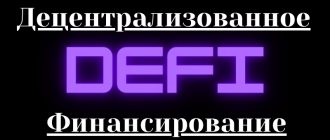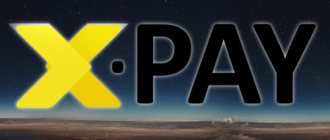Decentralized finance (DeFi) is a financial relationship carried out through funds that are formed within various enterprises, companies, households or individuals. DeFi refers to an ecosystem of financial applications that are built on top of blockchain networks.
The term "decentralized finance" can refer to a movement that aims to create an open, free and transparent financial services ecosystem that is accessible to everyone and operates without interference from any government authorities . Users will maintain full control over their assets and interact with this ecosystem through peer-to-peer (P2P) networks and decentralized applications (dapps).
The main advantage of DeFi is easy access to financial services, especially for those who are for some reason excluded from access to the current financial system. Another potential benefit is the modular framework and interoperability of applications based on public blockchains, which could lead to the emergence of completely new types of financial markets, products and services.
In this article, we will take a closer look at DeFi, its potential applications, prospects, limitations and much more.
What is decentralized finance?
Decentralized finance is a form of organizing monetary relations, the movement of funds of funds formed at the level of various enterprises, organizations, other economic entities, households and individual citizens.
Decentralized finance includes funds of funds that are formed outside of state and municipal finances. Belong to legal entities or individuals.
Decentralized finance, or open finance, aims to simplify traditional financial instruments such as lending, borrowing, derivatives and exchange. Instead of intermediaries, they use automation.
Fully automated DeFi blocks can be assembled to gain access to new, more comprehensive capabilities. At the moment, the main DeFi platform is the Ethereum (ETH) blockchain, but the open finance model can be implemented on any platform that works on the principle of smart contracts.
The role of smart contracts in DeFi
Most existing and potential applications in the field of decentralized finance involve the creation and execution of smart contracts.
While a regular contract uses legal terminology to define the terms between parties entering into an agreement, a smart contract uses computer code.
Since all terms are described in computer code, smart contracts have the unique ability to enforce them. This ensures reliable execution and automation of a large number of business processes that currently require manual control.
Smart contracts are much easier and faster to use, which has the effect of reducing the possible likelihood of adverse events for both parties. But despite this, they provide space for the emergence of new types of risk.
Since computer code is subject to errors and various vulnerabilities, your confidential information locked in smart contracts is at risk.
Functions of decentralized finance
All decentralized finance has its origin only through production, that is, this is the stage of economic processes when finance at a certain stage becomes money. This happens at the time of redistribution of goods and resources.
The whole essence of decentralized finance can be defined by its functions:
- A function based on the regulation of all financial relations within the company. All financial flows must be controlled and distributed within any enterprise, which allows for the competent distribution of the company’s resources, including money;
- Formation of the company's total capital and its distribution. This function is based on the competent use of funds and the system for their formation for the further development of the enterprise;
- Investment function. It allows you to determine financial resources that can be invested in the further development of the company, for example, the purchase of new equipment or a completely different area of activity that will generate additional income in the future;
- A function that is based on the distribution of the company's total income. This function is based on the process of correct formation of the company’s reserves: current, main, investment, future, etc. The financial system allows you to identify potential opportunities or problems that a company has at a given time.
Thus, the financial system is an integral element of a company’s activities in the market. Decentralized finance includes all relationships carried out using money.
Platforms working with DeFi
Let's consider the most popular platforms for financial relations, the object of which is decentralized finance. These are, for example, credit and deposit services, including InstaDApp and Compound. Decentralized exchange protocols are no less in demand, the advantage of which is instant conversion: the buyer exchanges one coin for another within a few minutes, which allows one to refuse the services of exchanges.
Platforms working with DeFi
Next come derivatives and forecasting services, the meaning of which lies in the name itself: they help predict the value of certain assets, find out their real price, and also make tokens yourself without outside intervention. Of course, one cannot fail to mention payment services that provide the opportunity to make transactions without commission. An example of such a network is the Lightning Network, created for Bitcoin. The latter, in turn, are in first place among cryptocurrencies, at the moment their value is $5262.26.
Where is the best place to buy DeFi tokens?
For safe and convenient purchase of cryptocurrencies, we have prepared a rating of the most reliable and popular cryptocurrency exchanges that support deposits and withdrawals of funds in rubles, hryvnias, dollars and euros.
The sites with the highest cash turnover are the most reliable. For several years now, Binance has been the largest cryptocurrency exchange in the world. The Binance platform is the most popular crypto exchange in the CIS, as it has maximum trading volumes, minimum commissions and supports transfers in rubles from Visa/MasterCard bank cards and payment systems QIWI, Advcash, Payeer.
Especially for beginners, we have prepared a detailed guide: How to buy Bitcoin on a crypto exchange for rubles?
| # | Cryptocurrency exchange | Official site | Site assessment |
| 1 | Binance (Editor's Choice) | https://binance.com | 9.7 |
| 2 | Huobi | https://huobi.com | 7.5 |
| 3 | Exmo | https://exmo.me | 6.9 |
| 4 | Yobit | https://yobit.net | 6.3 |
| 5 | OKEx | https://okex.com | 6.1 |
The criteria by which the rating is given in our rating of crypto exchanges:
- Reliability of operation
- stable access to all functions of the platform, including uninterrupted trading, deposits and withdrawals of funds, as well as the period of operation on the market and daily trading volume. - Commissions – the amount of commission for trading operations within the platform and withdrawal of assets.
- Reviews and support – we analyze user reviews and the quality of technical support.
- Interface convenience – we evaluate the functionality and intuitiveness of the interface, possible errors and failures when working with the exchange.
- Features of the platform are the presence of additional features - futures, options, staking, etc.
- The final score is the average number of points for all indicators, determines the place in the ranking.
How does decentralized finance work?
The DeFi ecosystem is based on decentralized applications (dApps) or protocols. Launching dApps on the blockchain allows the functioning of a peer-to-peer financial network that does not have central governing bodies. Ready-made defi apps can be combined with each other like Lego building blocks. The defi network structure is created on the basis of smart contracts and decentralized applications in the Ethereum ecosystem. Although this is not the only blockchain to launch a financial platform that guarantees you control over your assets.
Defi app developers are implementing open source protocols for trading through decentralized exchanges. Open source allows any programmer to create new financial products based on them. Developers can collaborate with each other to create new products.
Each network participant can securely store, trade and invest their assets in the blockchain and receive much higher income than from the traditional financial system.
Just like in a bank, users deposit their money and when someone borrows digital assets, they earn interest. Intermediaries are being replaced by smart contracts, with the help of which:
- There is a relationship between lenders and borrowers
- Loan terms are determined,
- Interest accrues.
The transparency of the blockchain and the absence of intermediaries allows lenders to receive higher income and better understand the risks.
How does lending work for the borrower?
The defi crypto lending scheme is reminiscent of pledging a valuable item to a pawnshop. If you need to borrow money, first deposit a certain amount of Ether tokens or other cryptocurrency. It is impossible for those users who do not have a penny to get a loan.
Upon expiration of the loan period, the borrower must return the borrowed funds with interest, and always in the same digital currency from which he borrowed coins. It can be a fiat asset or a crypt, but in any case its amount is fixed in US dollars or other national currency. The loan is usually issued in stablecoins, for example, USDC. The interest rate can be either fixed or floating; the terms of the loan depend on the reliability of the collateral cryptocurrency.
Thanks to defi services, you don’t have to sell digital tokens at an unfavorable rate. If the value of the collateral increases, the borrower will make a profit, and if the value of the collateral asset falls, the borrower will be in the red.
If the exchange rate drops significantly, the collateral may be sold before the position is closed. The borrower’s cryptocurrency is blocked on the platform, which acts as a guarantor of the transaction. Typically, defi projects launch lending pools. This means that the service accepts depositors’ money and issues secured loans, paying dividends.
How does lending work for a lender?
The lender on the decentralized finance platform is the same bank client who deposited the money. True, picking up crypto from the landing site is much easier than terminating the contract with the bank ahead of schedule.
The client is absolutely not worried about closing positions and interest calculation methods. If the amount of profit does not suit him, he takes the money and goes to another service.
Centralized collateral books for lending and borrowing
The collateral book of the Bitfinex cryptocurrency exchange looks like this:
The lines of the book contain information on the offers - the term and amount of the loan, as well as the interest rate per day. On the left are users who want to borrow funds, on the right are those who offer to lend them. In the top line is an offer with a minimum rate from the lender and a maximum from the borrower. In the second - a higher rate from the lender and a lower rate from the borrower.
This is how a centralized lending order book works. Deals are made when someone gives in and the parties agree on a price. Bitfinex provides a service for setting up an order book and selecting users, and in return takes a commission on each loan.
Differences between centralized finance and decentralized finance
A comparison will help to understand the prospects for the development of decentralized finance. Let's see how DeFi differs from the traditional financial system.
Characteristics of the traditional financial system:
- Who issues money - the state/central banks.
- What is money is state currency in the form of cash.
- Who is responsible for lending - banks.
- Who exchanges assets - exchanges and brokers like Nasdaq.
- What to invest in - stocks, bonds and other instruments with the help of banks and exchanges.
Characteristics of a decentralized finance system:
- How money is issued - in the form of a reward for mining on PoW and PoS algorithms. That is, miners find solutions to create a new block in the network and receive a reward for this in the form of new coins. The latter end up in circulation and are used by the entire community.
- What is money - cryptocurrencies and tokens.
- Who is responsible for lending - decentralized platforms that are controlled by the community. They significantly reduce the risk of cyberattacks, a problem that many centralized platforms struggle to overcome.
- Who exchanges assets - decentralized exchanges. The latter do not store user data and do not require showing your documents. They are just platforms for conducting transactions between traders.
- What to invest in - ICO, STO, IEO and baskets of tokens.
Centralized finance is formed at the macro level. Their source will be income from state and municipal enterprises, profit from privatization and sale of state or municipal property, income from foreign economic activity.
Decentralized funds, unlike the first ones, are formed at the micro level. They represent a set of regulated forms of organization, management of financial flows of business entities in the process of formation and use of gross income, cash and material savings. Such systems are represented by funds of commercial and non-profit organizations, and entrepreneurs.
Decentralization and the state
The current system of state and local revenues in the Russian Federation is based on the principle of unity. It is expressed in the fact that the legislation of the Russian Federation defines the types of income, the principles of their distribution between the Federation, its constituent entities and municipalities. If we take into account the procedure for the formation and use of state and municipal (local) revenues, they are divided into centralized and decentralized revenues.
Decentralized government revenues are the revenues of state (and municipal) enterprises and organizations that remain at their direct disposal and go to production as well as social needs. Mainly, this is part of the profits of enterprises. The funds of enterprises related to state or municipal property are assigned to such enterprises and belong to them under the right of economic management or operational management, like other property assigned to them (Articles 114, 115 of the Civil Code of the Russian Federation). The enterprise, after paying taxes, independently disposes of its profits and other income at its disposal.
Centralized (at different territorial scales) income includes income concentrated in state and local budgets and the same extra-budgetary funds. It is these incomes that the Civil Code of the Russian Federation refers to the federal state treasury, the state treasury of the constituent entities of the Federation, the municipal treasury, and distinguishes them from the funds assigned to state and municipal enterprises.
Key Benefits of DeFi
The traditional financial system relies on institutions such as banks, which act as intermediaries, and courts to ensure the resolution of disputes.
DeFi applications do not require intermediaries or courts. The code determines the resolution of each possible dispute, and users, in turn, keep all their funds under control. This reduces the cost of providing and using products, and allows for a more frictionless financial system.
With decentralized finance, users will have two incredible advantages over the current system:
- The ability to fully control assets and access to them. You no longer need to trust intermediaries who charge interest for their services. Everyone can access the service, and the system does not have a single control body.
- All protocols on which DeFi operates are open source. Accordingly, anyone can create a financial product based on them and come up with a new form of value creation. This will accelerate the development of innovation and strengthen the network effect, because with each new product more and more users and developers will switch to such platforms.
Although for this you need to have programming knowledge. An ordinary person without such experience is unlikely to be able to expand the capabilities of the DeFi ecosystem. Unless he is an investor, of course.
What is blockchain decentralization?
Decentralization is the distribution of power, finance, or effort without the intervention of a global governing body. A decentralized management system is far from new; many companies have it. However, in financial management such a system became possible only after the creation of the blockchain chain.
What does decentralization mean in blockchain? Let's turn to the algorithm of the system's functioning. In blockchain technology, decentralization of control is carried out without a local server, and all miners and participants in the transaction chain have equal rights.
Blockchain transactions are not monitored by developers, and transaction confirmations are carried out by network users. The technology involves the distribution of computing power, while information is duplicated many times to prevent loss, and DDOS attacks on such a system have zero or minimal effect.
What shapes the DeFi ecosystem?
To better understand decentralized finance, in the article we will analyze the following points:
- Stablecoins. DeFi building block. Unlike cryptocurrencies like Bitcoin or Ethereum, which are known for their volatility, stablecoins are designed to remain “stable,” equal to one unit of fiat currency. Most stablecoins are pegged to the US dollar, but other fiat currencies are also used. For example, the Chinese yuan.
- Decentralized lending. You can take out a loan on the blockchain without having a bank account.
- Decentralized exchanges. Buying and selling cryptocurrencies using the blockchain instead of a centralized exchange. For example, like on the Coinbase platform.
- Securing a loan (collateralization). Provide digital assets to back decentralized loans, creating a resource for the lender in case of default.
- Decentralized Idetity. Smart contracts use identifiers, for example, to confirm your solvency in the case of decentralized lending.
- Composability. Combining DeFi functions for various purposes. A similar principle applies to software libraries. For example, if one contract accepts cryptocurrency and generates interest, a second contract can reinvest that interest.
- Risk management. High returns in DeFi often come with equally high risks. Fortunately, new tools are emerging to reduce these risks.
Varieties of DeFi with examples
In general, decentralized finance consists of the latest monetary system, which is built on the basis of smart contracts and decentralized applications in the Ethereum ecosystem. It does not have central authorities and levers for its application.
Here everyone is equal: the capabilities of system participants do not differ depending on their place of residence, credit history, income and other common factors in the modern world.
The most promising areas for DeFi development:
- decentralized exchanges by type or KyberNetwork;
- stablecoins like Dai or USDC;
- baskets of tokens , that is, the decentralized equivalent of ETFs;
- asset management funds based on smart contracts like MelonPort;
- tokenized lending platforms like Fulcrum or Compound;
- decentralized prediction markets like Augur and Gnosis.
Why is decentralization needed in cryptocurrency?
The decentralized payment system provides a high level of security for transactions and storage of funds. Since information about the entire transaction history is stored by each user, such a system cannot be deceived or destroyed. Each transaction is confirmed by several independent nodes, which makes it impossible to replace data or bribe verifiers.
Unlike local systems that are used in banking structures, exchanging funds using a decentralized system takes significantly less time and will also allow you to complete a large number of transactions in seconds. Here the speed does not depend on the load and power of the local server. In the blockchain, computing power is distributed throughout the globe, and the chain participants themselves provide high power and speed.
The advantage of a decentralized electronic currency system is the absence of external regulation. For example, if the actions of a server are considered illegal by law enforcement agencies, they have the power to confiscate the owner’s equipment and developments. Decentralized cryptocurrencies are protected from this, because it is impossible to seize either the technology or the power, since they belong to people, and the technology is in the public domain. If at least one participant in the chain has it, it can be easily installed by everyone. The independence of cryptocurrencies from authorities and regulatory bodies also eliminates political manipulation of the value of cryptocurrencies. Therefore, the rate of cryptocurrencies is an honest reflection of supply and demand for them.
Challenges of using DeFi
- Poor performance. Blockchains are inherently slower than their centralized counterparts, leading to the creation of additional applications. DeFi application developers must take into account such limitations and optimize their products accordingly.
- High risk of user error. DeFi applications transfer responsibility from intermediaries to the user. This can be a negative aspect for many. Developing products that minimize the risk of user error is especially challenging when products are deployed on top of immutable blockchain networks.
- Poor user experience. Currently, using DeFi applications requires additional effort on the part of the user. For these applications to be a key element of the global financial system, they must provide tangible benefits that influence users' desire to move away from the traditional system.
- Ecosystem disorder. Finding the most suitable application can be quite a task, along with this, users must have certain skills to choose the best option. The challenge is also not only in creating applications, but also in thinking about how well they can fit into the larger ecosystem of decentralized finance.
Purpose of associations
Decentralized state funds formed from budget revenues are the main source of financing for government agencies. In some cases, it is possible for part of the money to come to the disposal of an enterprise that exists through its own production activities. This situation arises during the development and implementation of special government development programs. In this case, the funds received are used for the implementation and implementation of a new project. Under such a system, ministries and departments are financial managers. At the same time, decentralized monetary funds act as an intermediate distribution mechanism for funds from the state system to the final recipients.
Potential DeFi Use Cases
Loan and credit
Open lending protocols are one of the most popular types of applications in the DeFi ecosystem. Open decentralized borrowing and lending have many advantages over the traditional credit system. These include: instant settlement of transactions, the ability to secure digital assets, no credit checks, and potential standardization in the future.
Due to the fact that in this case, credit services are built on public blockchains, they minimize the required trust in them and provide a guarantee of the operation of cryptographic verification methods. Credit marketplaces on the blockchain reduce counterparty risk and make loans and credits cheaper, faster and more accessible to more people.
Monetary banking services
Since DeFi applications are financial by definition, it is obvious that they will have monetary banking services. These could include issuing stablecoins, mortgages and insurance.
As the blockchain industry develops, more and more attention is paid to the creation of stablecoins. They are a type of cryptocurrency that is tied to a real asset and can be digitally transferred with relative ease. Since cryptocurrencies are highly volatile, decentralized stablecoins can be adopted for everyday use as digital cash that is not issued or controlled by a central authority.
Due to the number of intermediaries that must be involved, the process of obtaining a mortgage is quite expensive and lengthy to process. With the use of smart contracts, underwriting and legal fees can become significantly cheaper.
Blockchain insurance can eliminate the need for intermediaries and allow risks to be spread across multiple participants. This could lead to lower insurance premiums without affecting the quality of service.
Decentralized markets
This category of applications can be difficult to evaluate, since the DeFi segment itself provides a large number of opportunities for various financial innovations.
Perhaps some of the most important DeFi applications are decentralized exchanges (DEXs). Such platforms allow users to trade digital assets without the need for a trusted intermediary (an exchange) to hold your funds. Transactions are made directly between user wallets using smart contracts.
Because these trading platforms require much less maintenance, decentralized exchanges charge lower trading fees than their centralized counterparts.
Blockchain technology can also be used to issue and authorize ownership of a wide range of traditional financial instruments. Such applications will operate in a decentralized manner, which eliminates the presence of a single point of failure and custodians.
For example, security token issuing platforms can provide issuers with the tools and resources to launch tokenized securities on the blockchain with customizable parameters.
Other projects will be able to afford to create derivatives, synthetic assets, decentralized forecasting markets and much more.
Popular DeFi services
Let's briefly talk about the largest decentralized finance platforms:
- The Compound service was in the shadow of MakerDAO for a long time, but after the release of native tokens, Comp quickly overtook its competitor and took first place in the DeFi Pulse rating. The main activity of the defi application is borrowing and lending on the blockchain.
- MakerDAO is more than a lending service; it can be called a decentralized reserve bank. The platform has its own stablecoin DAI backed by the crypto asset ETH.
- Sparkdex is a defi exchange running in the Bitspark ecosystem. Supports top cryptocurrencies, Bitcoin and Ethereum, as well as most stable coins. Clients are guaranteed complete security of assets.
- Augur can be called the original defi prediction exchange. Clients bet on one or another outcome of events or offer their own version, adding value to voting with ecosystem tokens. Augur is a kind of futures market. You bet on the expected direction of events and create long or short positions.
- Aave is an open-source, non-custodial protocol that enables the creation of money markets. Savers provide liquidity in the market to earn passive income, while borrowers can take out loans with fixed or variable interest rates. The EthLend peer-to-peer network is based on the Ethereum blockchain, and the internal cryptocurrency Aave (LEND) is used as a collateral asset.
The essence of classical finance
The term finance comes from Lat. financia, meaning income, payment in a transaction. It first appeared in the trading cities of Italy in the 13th-15th centuries.
The essence of finance, the patterns of its development, the scope of commodity-money relations covered by it and its role in the process of social reproduction are determined by the economic system of society, the nature and functions of the state.
The emergence of finance is due to factors such as:
- social division of labor and division of society into various social groups;
- development of commodity-money relations in connection with the growth of production and increase in GDP and ND (national income);
- the emergence of independent, independent business entities carrying out entrepreneurial activities and creating the necessary funds for production;
- creation of a centralized state.
Finance represents economic, monetary relations associated with the formation, distribution and use of funds of funds in order to ensure conditions for expanded reproduction and the fulfillment of the functions and tasks of the state.
Finance as an economic category expresses economic relations regarding the production, distribution and use of gross domestic product (the value of final goods and services produced within a given country over a certain period) and national income (newly created value (or value of GDP) minus the instruments consumed in the process and means of production).
At the production stage, GDP and ND are created. At the distribution stage, financial relations arise. Without the participation of finance, GDP and ND cannot be distributed. Production has four stages: production, distribution, exchange, consumption.
Finance appears in monetary form, but not all monetary relations are financial. Monetary relations turn into financial ones when, as a result of the production of goods and the provision of services during their sale, funds of funds are created. This applies to all areas of economic relations.
As a result of the independent movement of money, funds are formed: centralized and decentralized, this expresses the material content of finance.
Comparative characteristics of money and finance
| Money | Finance |
| a universal equivalent by which the costs of producers of goods are measured. | economic instrument for the distribution and redistribution of GDP and income, instruments for controlling the formation and use of funds of funds |
| functions: measure of value, medium of exchange, means of accumulation and savings, means of payment, world money | functions: distribution, control, (regulating) |
| money originated 26 centuries ago | finance originated 8 centuries ago |
| more general economic category | secondary category derived from money |
| cover broad economic relations | cover narrower relationships related to the formation of monetary funds |
Financial relations arise between:
- enterprises in the process of acquiring inventory, selling products and providing services;
- enterprises and higher organizations (concerns, holdings, financial and industrial groups) when creating funds of funds and their distribution;
- enterprises in the formation of the circulation of its funds;
- within the household when forming and using the family budget;
- by the state and the enterprise when the latter makes mandatory payments to the budget system, as well as financing expenses from the budget;
- the state and citizens and extra-budgetary funds when making payments and receiving funds;
- individual parts of the budget system, etc.
Industry associations
There are associations at the disposal of ministries and government agencies that regulate the industry or sphere of government at the federal level. The main task performed by such decentralized state funds is to solve problems that have arisen in a particular industry or area of management. Their place in the financial state system is intermediate. They are located between the funds of state institutions and centralized ones. The main task of the controlling structures is the qualitative redistribution of funds received from the intermediate association between their final consumers. The latter are state budgetary institutions. In turn, the financial resources received by these organizations are the basis for the formation of their own funds.











